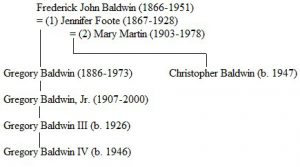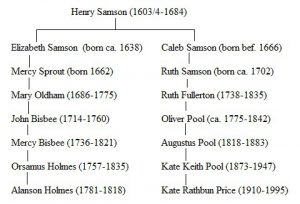 A (non-genealogical) post I read recently involved someone referring to a relative of an older generation as a “second cousin.” I asked further about the kinship, and this person was actually the author’s mother’s first cousin, and thus the author’s “first cousin once removed,” which is a common mistake in kinship assignment. However, it got me thinking about how much “generational spread” can occur even in a comparatively short period of time.
A (non-genealogical) post I read recently involved someone referring to a relative of an older generation as a “second cousin.” I asked further about the kinship, and this person was actually the author’s mother’s first cousin, and thus the author’s “first cousin once removed,” which is a common mistake in kinship assignment. However, it got me thinking about how much “generational spread” can occur even in a comparatively short period of time.
My oldest second cousin was born in 1949 (two years before my father), as my father is the youngest grandchild on his father’s side and this second cousin of mine is the eldest child of my father’s eldest first cousin. My own first cousins, all on my mother’s side, range in birth years from 1970 to 1988; cousins in the next generation were born between 1990 and (to date) 2016.
Significant differences in the ages of generations occur when a male has children later in life.
My wife’s family has even more generational spread. Her mother is the tenth of eleven children, and she has nieces who were born before she was. On this side my wife’s eldest first cousin was born in 1955 and the youngest in 2004 (I think!). My father-in-law is the third of seven children, and the cousins’ birth years range from 1967 to 2015.
Significant differences in the ages of generations occur when a male has children later in life. The example given above (names are changed) concerns a friend’s ancestor who had a first “batch” of children in his twenties. He married again at age 63 and had his youngest child at age 81. In this case, he had great-great-grandchildren born before his youngest child.
Often, when recognizing common colonial ancestors with members, I’ll determine our kinship; it is usually anywhere from ninth to twelfth cousins, zero to four times removed. The generations apart is not often indicative of our actual ages, reflecting a generational spread that occurs over time. Sometimes we are the same generation genealogically but fifty years apart in age. Other times we might be the same age but four genealogical generations apart.
 Using the Mayflower Families for Five Generations series, I looked in the Henry Samson volumes, since this passenger had nine children and these books trace many descendants for seven generations, to see examples of significant generational spread. The following chart might not be the most extreme in these volumes, but represents the varying ages in the same generation.
Using the Mayflower Families for Five Generations series, I looked in the Henry Samson volumes, since this passenger had nine children and these books trace many descendants for seven generations, to see examples of significant generational spread. The following chart might not be the most extreme in these volumes, but represents the varying ages in the same generation.
In this above example, by the eighth generation the spread goes across three centuries, from 1781 to 1910. Does anyone have an example within eight or so generations going across four centuries? I would think this could be possible, if the “senior” line has a birth in the late 1700s, while a “junior” line, made up largely of men having children late in life, could extend to the beginning of this century.
This is fascinating, Christopher, and I suspect the reason that some people just “grab” at an ancestor due to a name that fits and pop it into their tree, without researching the dates from original sources. More damage has been done to genealogy through online guessing….
Of course, it is complicated by the fact that families frequently used the same names over and over, and as they moved west (as many got “western fever”) they re-used the names, not even realizing that second cousin Jones named his new son the same name last year!
Good stuff Chris! It’s hard to imagine a spread across four centuries. I am hoping someone out there will have one. The Samson example is amazing!
This is very timely for me as I have been looking for misrepresented relationships. Recently reading step, in law, cousin, sister and brother references may not be correct for genealogical purposes. Most of us have heard phrases like” my sister, but not really but she’s like my sister” and in an effort to be polite have not pushed the question. Thank you. I enjoy your blogs.
Not 300 years like your example, but my paternal 5th great grandfather Hans Johann Laferre, was born 259 years before me, 1700 vs 1959. There’s only one father-son in this line that has a greater than typical age spread, 59 years.
Still thinking about this… I have a maternal 2nd cousin born in 1929 and another born in 1972 (same great grandparents), these two 2nd cousins have children born in 1952 and the other 2006. No where near your 129 year example, but I could imagine that following these two lines into the future for three more generations it could happen. 1952 3rd cousin has grandchildren, 2006 3rd cousin is not yet a teenager.
My father-in-law used to love telling everyone that he was older than his aunt. The age difference was only two months (April 22, 1905 vs. July 1, 1905), but they went to the same elementary school and loved confusing their friends! Pop’s mother was 21 years older than her youngest sister. She was the first child, her sister the 10th, with the same set of parents.
We Converses may be an example: Edward Converse (1588-1663) arrived in the Winthrop fleet in 1630. Of the lines I have traced, my own brother (born 1950) is only the 8th generation from Deacon Edward, but other male Converses living today are 9, 10 and 11 generations after Edward, depending on the line. It shows how the age of the fathers adds up!
I am part of a wide generational spread in my family. My parents were 44 when I was born and my siblings were 17 and 19 at the time. And my father was also born in my position, in that he had siblings 15 and 17 years older than him. So, people are quite surprised when I announce that my father served in WWII and my uncle served in WWI. I was born in 1957.